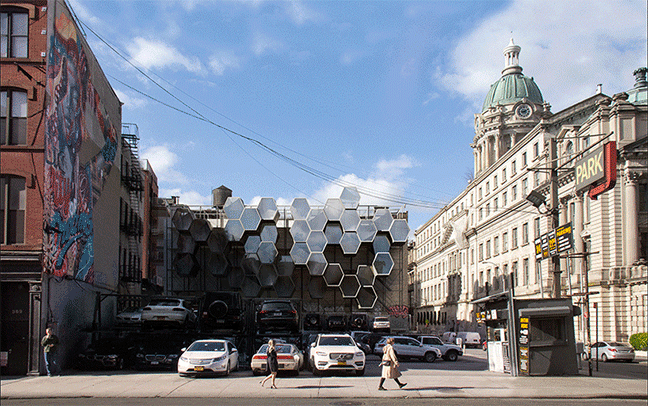Submitted by Elif Merve Unsal
Framlab Designed honeycomb-shaped "Homed" to give shelter to New York's Homeless
United States Architecture News - Nov 19, 2017 - 08:28 29815 views

"Homed is a project that sets out to eradicate homelessness in New York City, by utilizing idle building facades, scaffolding, and 3D-printed spatial modules," the way that Framlab defines their project.
Homelessness in New York City is growing each day and the shelter system in the city has reached its capacity, and the increasing land prices in the city resulted in the reduction of available land to build on.
Oslo and New York City-based agency Framlab have proposed a creative solution to provide a-year round sheltering for its residents.

The project, called "Homed", is a solution which brings the idea of using 'vertical lands' of the city. Consisting of clustered 3D-printed hexagonal housing modules, the project proposes a second layer of vertical micro-neighborhood on top of the empty wall by being connected to a scaffold structure on the wall. The system reveals the potential of utilizing the land that otherwise is difficult and expensive to develop.
 By taking the advantage of pre-fabrication technologies, the system allows to be deployed or relocated quickly. Homed communities can be created or moved to wherever the need exists in a matter of days. A typical 50 feet x70 feet wall can host up to 95 units.
By taking the advantage of pre-fabrication technologies, the system allows to be deployed or relocated quickly. Homed communities can be created or moved to wherever the need exists in a matter of days. A typical 50 feet x70 feet wall can host up to 95 units.

The hexagonal units consist of different layers. While steel and aluminum are used as the materials for exterior of the units to be compatible with the cityscape, the interior of the units are made up 3D-printed recyclable bioplastics. Besides the interior of the unit is designed with a range of smart technologies to provide a comfortable space for its resident.

The interior configuration of the units will be able to be changed according to spatial and functional needs and wishes. In addition, different type of units can be combined to create a wide unit. This gives the project flexibility while keeping the scope of sustainability aspects of the project.



3D-Printed Models of Units



The 3D-printed modules allow furniture, cabinets and equipment to be integrated into the structure, allowing for a minimal space that does not need additional furnishing and accessories.

The front facade of the units is made up of smart-glass assembly with a layer of thin film diodes which allows presenting itself to the cityscape. The facade would be altered into a digital artwork or public information or commerical advertisement at night.
Framlab says "it is important to stress that Homed is not proposed as a singular solution to the situation. Rather, it is intended to be an instrument that plays a part in the solution. The massive extent and complexity of the situation requires work on a broad regulatory and policy-making level. But, it is critical that the design community is part of the process."

All images © Framlab
> via Framlab
